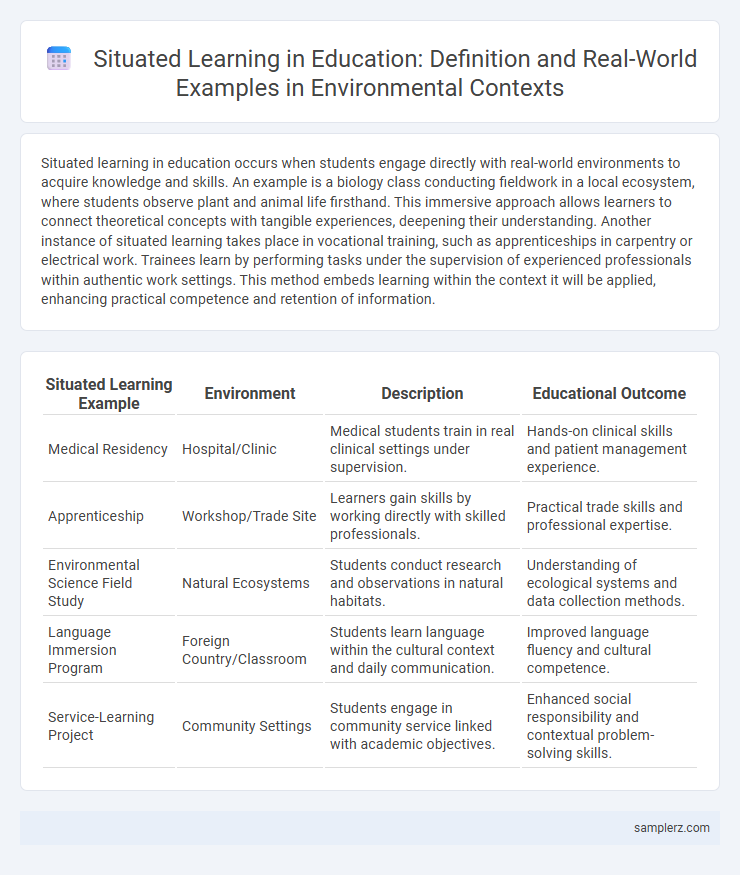Situated learning in education occurs when students engage directly with real-world environments to acquire knowledge and skills. An example is a biology class conducting fieldwork in a local ecosystem, where students observe plant and animal life firsthand. This immersive approach allows learners to connect theoretical concepts with tangible experiences, deepening their understanding. Another instance of situated learning takes place in vocational training, such as apprenticeships in carpentry or electrical work. Trainees learn by performing tasks under the supervision of experienced professionals within authentic work settings. This method embeds learning within the context it will be applied, enhancing practical competence and retention of information.
Table of Comparison
| Situated Learning Example | Environment | Description | Educational Outcome |
|---|---|---|---|
| Medical Residency | Hospital/Clinic | Medical students train in real clinical settings under supervision. | Hands-on clinical skills and patient management experience. |
| Apprenticeship | Workshop/Trade Site | Learners gain skills by working directly with skilled professionals. | Practical trade skills and professional expertise. |
| Environmental Science Field Study | Natural Ecosystems | Students conduct research and observations in natural habitats. | Understanding of ecological systems and data collection methods. |
| Language Immersion Program | Foreign Country/Classroom | Students learn language within the cultural context and daily communication. | Improved language fluency and cultural competence. |
| Service-Learning Project | Community Settings | Students engage in community service linked with academic objectives. | Enhanced social responsibility and contextual problem-solving skills. |
Real-World Science Labs: Immersive Learning in Nature
Real-world science labs provide immersive learning experiences by engaging students directly with natural environments, fostering hands-on exploration of ecological concepts and scientific methods. Fieldwork in forests, wetlands, or gardens enables learners to observe biodiversity, conduct experiments, and collect data in authentic contexts that enhance critical thinking and problem-solving skills. This situated learning approach bridges theoretical knowledge with practical application, promoting deeper understanding and retention of environmental science topics.
Community Gardens: Hands-On Environmental Education
Community gardens offer a dynamic example of situated learning by engaging students directly with the environment through hands-on activities like planting, composting, and ecosystem observation. This experiential education fosters ecological literacy and social responsibility as learners collaborate to maintain green spaces and observe real-world environmental processes. Through active participation, students develop practical skills and contextual knowledge that connect classroom concepts to tangible community impact.
Field Trips to Ecosystems: Learning Beyond the Classroom
Field trips to ecosystems offer immersive situated learning experiences where students engage directly with natural environments such as forests, wetlands, or coral reefs. By observing plant and animal interactions, soil composition, and water cycles firsthand, learners develop deeper ecological understanding and critical thinking skills. This experiential approach enhances retention and fosters environmental stewardship through authentic, context-rich education beyond traditional classrooms.
Outdoor Classrooms: Merging Curriculum with Nature
Outdoor classrooms integrate environmental elements directly into the learning process, enhancing student engagement through hands-on experiences with natural ecosystems. This approach supports situated learning by contextualizing academic concepts within real-world settings, such as using local flora and fauna to teach biology or applying weather observations to explore earth sciences. Research indicates that outdoor classrooms improve retention and foster critical thinking by actively involving students in their immediate environment.
Environmental Service Learning Projects
Environmental Service Learning Projects immerse students in real-world ecological challenges, fostering hands-on education through community engagement and sustainability efforts. Participants collaborate with local organizations to address issues like habitat restoration, waste reduction, and water quality monitoring, enhancing environmental literacy and civic responsibility. This situated learning approach strengthens problem-solving skills and deepens understanding of ecological interdependencies.
Nature-Based Problem Solving Activities
Nature-based problem solving activities immerse students in real-world ecosystems, encouraging hands-on exploration and critical thinking to address environmental challenges such as habitat restoration or water quality assessment. These situated learning experiences foster deeper understanding of ecological concepts and promote collaboration, as learners engage directly with natural settings to analyze problems and develop sustainable solutions. Incorporating local flora and fauna into problem-solving tasks enhances engagement and contextualizes scientific principles within the living environment.
Local Wildlife Observation for Ecological Understanding
Local wildlife observation in ecological understanding enriches situated learning by immersing students directly within their natural habitats to study flora and fauna behaviors. This experiential approach leverages real-time data collection and environmental interactions, fostering deep cognitive connections and retention of ecological concepts. Educational institutions integrating this method report increased student engagement and improved comprehension of biodiversity and ecosystem dynamics.
Collaborative Conservation Initiatives with Students
Students engaged in collaborative conservation initiatives apply situated learning by participating in real-world environmental projects, such as habitat restoration and species monitoring. This hands-on approach immerses learners in authentic conservation environments, fostering critical thinking and teamwork skills. These initiatives, often conducted in partnership with local ecological organizations, enhance students' understanding of biodiversity and ecosystem management.
Place-Based Learning in Urban Green Spaces
Place-based learning in urban green spaces immerses students in real-world ecological and social challenges, enhancing environmental literacy and community engagement. By exploring local parks, gardens, and natural habitats, learners develop practical skills in sustainability, biodiversity, and conservation. This hands-on approach fosters a deep connection to the urban environment, promoting stewardship and informed decision-making.
Eco-Friendly School Programs for Experiential Learning
Eco-friendly school programs promote situated learning by integrating hands-on environmental projects within the local ecosystem, such as creating sustainable gardens and conducting waste reduction campaigns. These initiatives immerse students in real-world ecological challenges, fostering critical thinking and environmental stewardship. Through active participation, learners develop practical skills and awareness essential for sustainable living.

example of situated learning in environment Infographic
 samplerz.com
samplerz.com